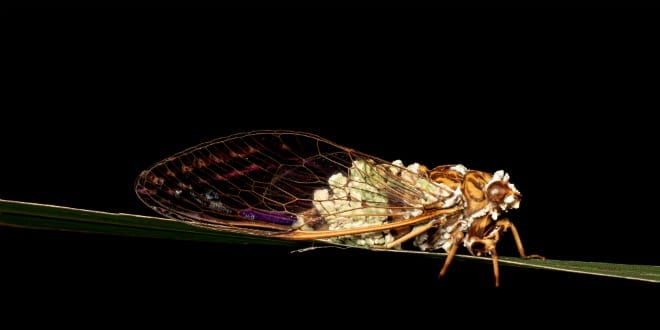Researchers in West Virginia discovered that the local cicadas had been infected by a mind-controlling fungus that caused them to act strangely in order to facilitate the spread of the disease, exhibiting what was described as “hypersexual behavior”. Parts of the insects’ bodies are replaced by the fungus which just wore away, while the fungus keeps the mortally wounded cicada alive.
Researchers in West Virginia discovered that about one-third of the cicadas, small winged insects that appear every year, was under the influence of Massospora, a psychedelic fungus that contains chemicals such as those found in hallucinogenic mushrooms. The chemicals cause the infected cicadas to trick other cicadas in order to facilitate the spread of the fungus, manipulating male cicadas into flicking their wings like females – a mating invitation – which tempts unsuspecting male cicadas and infects them. The research, “Behavioral betrayal: How select fungal parasites enlist living insects to do their bidding,” was published in the journal PLOS Pathogens.
“Essentially, the cicadas are luring others into becoming infected because their healthy counterparts are interested in mating,” said Brian Lovett, study co-author and post-doctoral researcher with the Davis College of Agriculture, Natural Resources and Design. “The bioactive compounds may manipulate the insect to stay awake and continue to transmit the pathogen for longer.”
In true horror movie fashion, Massospora spores gnaw away at a cicada’s genitals, butt and abdomen, replacing them with fungal spores. Then they “wear away like an eraser on a pencil,” Lovett said.
The fungus manipulates the insects’ behavior to keep the host alive rather than killing them to maximize spore dispersal.
“If one of our limbs were taken out or if our stomach was slashed open, we would probably be incapacitated,” co-author, Matthew Kasson told CNN. “But infected cicadas, despite the fact that a third of their body has fallen off, continue to go about their activities like mating and flying as if nothing happened. This is really, really unique for insect killing fungi.”
Even though infected cicadas lose their ability to mate when their hindquarters are replaced by the fungus, they will still attempt to mate to sexually transmit the fungus to healthy cicadas in what researchers described as “hypersexual behavior.”.
“When they fly around or walk on branches, they spread spores that way too,” Kasson said. “We call them flying saltshakers of death, because they basically spread the fungus the way salt would come out of a shaker that’s tipped upside down.”
Lovett compared the transmission of the behavior-modifying virus to rabies.
Both rabies and entomopathogenic fungi (parasites that destroy insects) enlist their living hosts for successful “active host transmission,” Lovett said.
“When you’re infected with rabies, you become aggressive, you become afraid of water and you don’t swallow,” Lovett said. “The virus is passed through saliva and all of those symptoms essentially turn you into a rabies-spreading machine where you’re more likely to bite people.
“In that sense, we’re all very familiar with active host transmission. Since we are also animals like insects, we like to think we have complete control over our decisions and we take our freewill for granted. But when these pathogens infect cicadas, it’s very clear that the pathogen is pulling the behavioral levers of the cicada to cause it to do things which are not in the interest of the cicada but is very much in the interest of the pathogen.”
As bizarre as the infection sounds, it is generally harmless to humans and cicadas alike. The insects reproduce at such a rate that the fungi’s extermination of hordes of cicadas has little effect on their overall population.
“They’re very docile,” Lovett said. “You can walk right up to one, pick it up to see if it has the fungus (a white to yellowish plug on its back end) and set it back down. They’re not a major pest in any way. They’re just a really interesting quirky insect that’s developed a bizarre lifestyle.”
Cicadas have either a 13 or 17-year lifecycle and live underground until they emerge more than a decade later, studying how Massospora infects these species can be very difficult.




